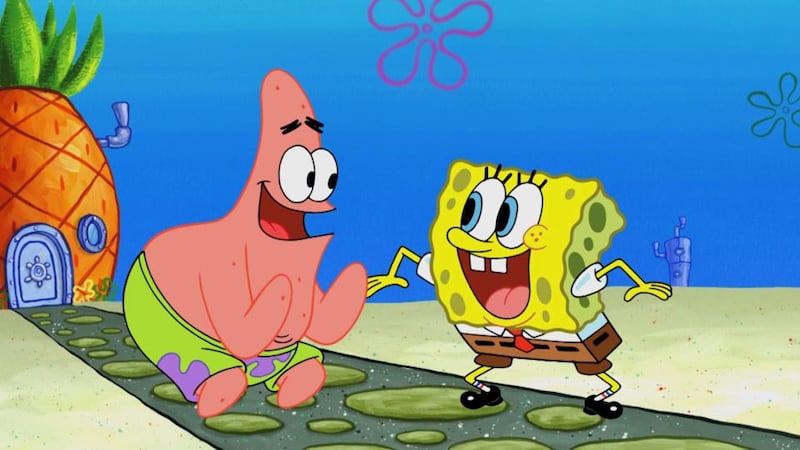Few creative acts strike me again and again with such joy as SpongeBob SquarePants. Grinning out from a child’s backpack, or his goofy features cast in milk and sugar and stuck on a lolly stick, the cartoon character is so ubiquitous as to almost become unremarkable. But like all truly great art, its power renews itself: wait, yes, that really is a sponge, with arms and legs and a face, wearing short trousers and a shirt and tie and shiny black boots, and he wants to be everyone’s friend.
The rediscovery is a jolt of sheer delight. The very fact SpongeBob exists at all feels almost like proof of the existence of God: the inspiration needed for something of such pure originality has to be divine.
Wherever the inspiration came from, it was made sponge by Stephen Hillenburg, the character's creator, who has died tragically young, at 57 years old, of motor-neuron disease. Across 242 episodes, two movies (plus a third incoming), a Broadway musical, thousands of memes and your kid's lunch box, his creation has become a cultural titan.
Twentysomethings thank me for their childhood. SpongeBob lives at the bottom of the sea, but he brings a lot of great stuff to the surface
Hillenburg, whom I was fortunate enough to interview in 2016, a year before he revealed he was ill, had been nuts about life under the sea ever since a childhood reared on scuba-diving and Jacques Cousteau. He was essentially a failed marine biologist who went into cartooning because he was better at it, working first on the Nickelodeon show Rocko's Modern Life. This was just one of the surrealistic, deadpan cartoons that populated 1990s American TV, a countercultural strain that SpongeBob was synthesised from and Hillenburg perfected.
There are echoes of the Ernst-like plasticity of Ren & Stimpy and the pop-art brashness of Aaahh!!! Real Monsters, with just the occasional parent-facing deadpan gag, the kind that peppered Rugrats, Dexter's Laboratory and, later, the Shrek movies. But brilliant as these creations often are, none had the radical naivety of SpongeBob: it was his eternal, reflexive positivity, gifted to him by Hillenburg, that made him truly exceptional.
As Tom Kenny, the voice of SpongeBob, told me, the show has “comedic archetypes that have worked for hundreds of years, further back than Shakespeare”. Hillenburg stripped our world back to literal cartoon versions of human behaviour. SpongeBob is the idealist, met with both cynicism (Squidward, Plankton and Mr Krabs, a triptych of venality) and chaos (best friend Patrick, a starfish of pure id). Off they go for 11 minutes at time, the oppositional energies colliding. It usually goes badly for SpongeBob to begin with, those eyes suddenly huge and brimming – but in the end he triumphs, often thanks to errors the others make because of their self-interest or negativity. So often children are told merely to “be yourself”, but what if that self is corrupted? SpongeBob evolves the message: fill your heart with kindness and then be yourself. The world will bend to you without your trying.
It’s this purity of intent that makes SpongeBob so globally popular, and such an absorbent medium for online memes. Hop on Twitter or Instagram and you are never far from an “evil Patrick”, used to illustrate amusing misdeeds, or SpongeBob himself, looking relieved, angry, stoned or indeed any other human mood. The memes work because we both see ourselves in SpongeBob and aspire to be him. He is flawed, vulnerable but endearing, while being quietly, mutably omnipotent.

When I spoke to Hillenburg I expected big energy, someone yakking like SpongeBob himself. But there was something careful and truly childlike about him: it was clear that SpongeBob’s very naivety was an extension of his personality. He was as reflexively, unwittingly comic as SpongeBob, too: “SpongeBob is just made of cellulose, but he has parents who are natural sponges – he got the square gene,” he told me straight.
His description of the original pitch he made to Nickelodeon, meanwhile, is the kind of pitch SpongeBob would make for a show about himself: “When I pitched the show I made this special seashell. You could pick it up and hear me singing: ‘Spongeboy, Spongeboy!’ I also made an aquarium with Patrick planted on the side, SpongeBob sitting on a barrel and Squidward inside. I wore a Hawaiian shirt. I don’t know what they thought of it. Eventually we pitched with a storyboard. The executive, Albie Hecht, walked out – then walked straight back in and said: ‘Let’s make this.’”
Thank God he did. Since he first appeared, in 1999, SpongeBob has evolved into a paragon of hard work, tenacity and moral fibre; with his job as a short-order chef, he is one of the few working-class heroes on US television; his friendship with Patrick is movingly pure. As Kenny told me: “Twentysomethings thank me for their childhood… SpongeBob lives at the bottom of the sea, but he brings a lot of great stuff to the surface.”
Hillenburg had wanted to call SpongeBob “Spongeboy”, but he was foiled by a mop company. “I eventually thought of SpongeBob, but he needed a last name – SquarePants came to mind,” he said, with perfect blitheness, as if the name were as workaday as Smith or Jones. It was a reminder that true artistic genius is never aware of itself. Hillenburg has died too young, but his legacy as a loud surrealist and quiet moralist is unique, and shows that he lived as we all should: like a bright, confident sponge. – Guardian











